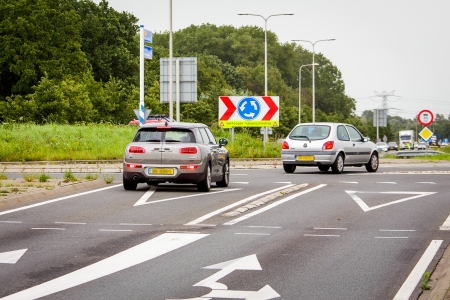Intersections may be subdivided by type, priority regulation and layout.
Intersection types
Table 1 shows the different intersection types.
|
Intersection type |
Description |
|
|
Four-legged intersection (+ of X)
An intersection where two roads cross and traffic exchanges between both roads are possible [2]. The legs can either be at right angles (+), or not (X) |
|
|
Three-legged intersection (Y of T)
An intersection at which one road ends as it joins another road [1] [3]. Three road sections thus meet, either in a T shape (T junction), or in a Y shape (Y junction). |
|
|
Staggered junction
Consists of two three-legged junctions that are close but opposite to each other. It is actually a variant of a four-legged intersection. This type of intersection may only be called a staggered junction when the four roads connect [4] |
|
|
Roundabout
This is an at-grade intersection on which traffic flows in a circular movement. Traffic on the roundabout has right of way and the roads have radial connections [1] |
|
|
Bow-legged intersection (new intersection type)*
A bow-legged intersection is a relatively new intersection type that combines elements of a roundabout and a priority intersection. An important characteristic is that the main high-volume traffic flow has right of way over the lateral flows. In this way it differs from a roundabout. A slight bend in the main carriageway ensures a speed reduction at the junction location. In addition, a median island ensures the circular movement of traffic flows and reduces speeds [5]. |
Table 1. Intersections by type[i] . *In the figure GOW stand for distributor road and ETW for access road.
Intersections distinguished by priority regulations
- Unprioritised intersection. An intersection without specific priority regulation, but drivers coming from the right automatically have priority [1].
- Prioritised intersection. There are two kinds:
Intersections distinguished by layout
- With or without physical speed reduction measures. Physical speed reduction may take the form of a raised junction, speed humps or a roundabout[6].
- With or without separate cycling facilities. Each of the intersections discussed above either do or do not feature separate cycling facilities. There are different cycling facilities at conventional intersections within the urban area, but also at crossings, such as bicycle/moped tracks, main bicycle routes, solitary bicycle/moped tracks, bicycle streets and bicycle lanes. Outside the urban area, bicycle/moped tracks can be found at intersections, and solitary bicycle/moped tracks and bicycle routes form junctions with the main carriageway (either at-grade or grade separated by means of a tunnel or viaduct) or are integrated at the road network intersection [1].
- With or without separate pedestrian facilities. Intersections feature several different pedestrian facilities [1]. Some have zebra crossings and some have separate pedestrian traffic lights. Pedestrian traffic lights coincide with canalisation markings. Median islands ensure that roads can be crossed in stages. Finally, pedestrian tunnels and bridges allow for safe grade separated crossing. They are mainly located at through-roads and distributor roads.
- With or without separate public transport facilities. Intersections where public transport lanes cross other roads are usually priority intersections, intersections with separate traffic lights for public transport, intersections with regular traffic lights, or roundabouts to which the public transport lane connects. Public transport is given right of way wherever possible, to enhance its desired maximum flow, frequency and punctuality [1].
In practice, a lot of variations on the abovementioned intersection types exist. Uniformity of intersections is therefore limited, often because of the traffic situation on site, costs and the available space. Another reason for the lack of uniformity is that formal Dutch guidelines do not exist. Instead there are recommendations, as laid down in ‘ASVV 2012’[ii] [7] and the ‘Handboek Wegontwerp 2013’ (Road Design Manual) [8], both by CROW.
[i] There are also gyratories, but these have not been included since they are rather scarce.
[ii] The new ASVV is expected for the autumn of 2021.
